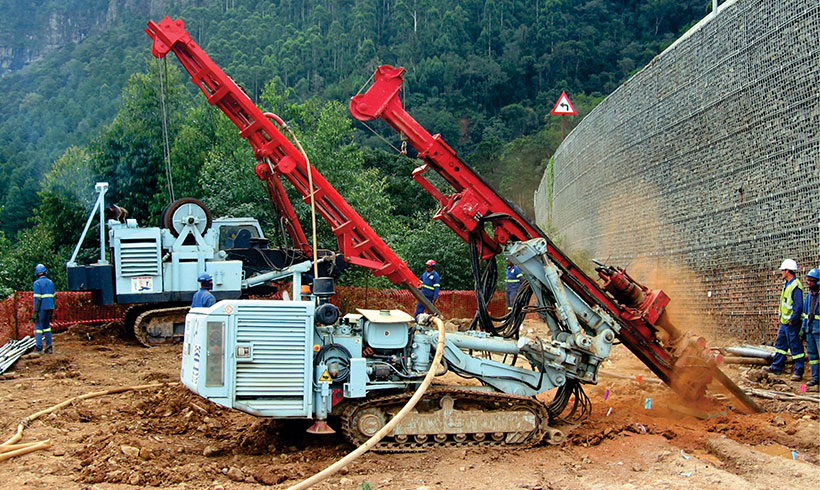5 Easy Facts About Geotechnical Engineering For Construction Projects Described
Geotechnical Engineering For Construction Projects for Beginners
Table of ContentsThe Definitive Guide to Geotechnical Engineering For Construction ProjectsGeotechnical Engineering For Construction Projects for BeginnersThe Greatest Guide To Geotechnical Engineering For Construction ProjectsThe 6-Minute Rule for Geotechnical Engineering For Construction Projects4 Simple Techniques For Geotechnical Engineering For Construction ProjectsThe 10-Minute Rule for Geotechnical Engineering For Construction Projects
The duty of geotechnical design significantly takes care of realizing the features of dirt and rock, which might vary substantially by their thickness, moisture web content etc. These features must be analyzed by geotechnical engineers to forecast their movements under various conditions. The safety as well as stability of structures are influenced by dirt problems, making this evaluation necessary., in addition to exactly how they connect with buildings that have actually been set up on or within them, is one of the primary explanations for why geotechnical engineering is vital.
Along with structural preparation and construction, geotechnical engineering is likewise vital to the restoration and maintenance of pre-existing structures. Age-related degradation or extra troubles can affect a structure's stability and performance. Environmental management is accomplished with geotechnical design. Proficiency in air, water, and soil top quality maintenance is used by geotechnical designers to decrease the negative effects of projects.
Infrastructure development, offshore engineering, tunnel construction, and deep foundations. Risk-based layout and multidisciplinary groups. These parts will certainly maintain the area advancing and ensure its ongoing importance in the years ahead. To summarize, geotechnical engineering is a crucial self-control that protects the durability and integrity of civil infrastructure. Geotechnical designers add to making structure jobs efficient around the globe by recognizing the behaviour of planet materials and applying appropriate planning approaches.
The Main Principles Of Geotechnical Engineering For Construction Projects
The foundational stability of any job is crucial. Geotechnical design plays an important role in guaranteeing that frameworks are built on strong ground, essentially and figuratively. By analyzing dirt, rock, and subsurface problems, geotechnical engineers provide crucial insights that help in the style, building and construction, and maintenance of buildings and facilities.

10 Simple Techniques For Geotechnical Engineering For Construction Projects
Lab testing: Determining the buildings of dirt and rock. Area screening: Performing examinations on-site to assess conditions. Analysis and style: Making use of data to design structures, maintaining walls, passages, and other structures. Several high-profile building jobs have successfully utilized geotechnical design to ensure their security and safety. As an example:: The world's tallest structure required a deep understanding of the underlying geology.

As a leader in geotechnical design, BECC Inc. is dedicated to providing ingenious and effective remedies that fulfill the greatest standards of top quality and safety., a mechanical designer and rock hound.
The Best Strategy To Use For Geotechnical Engineering For Construction Projects
Terzaghi also developed the structure for concepts of bearing capability of foundations, and the theory for forecast of the price of more tips here settlement of clay layers due to consolidation. Afterwards, Maurice Biot totally created the three-dimensional dirt debt consolidation concept, extending the one-dimensional version previously established by Terzaghi to extra basic hypotheses and presenting the collection of standard formulas of Poroelasticity.
Geotechnical designers investigate and figure out the properties of subsurface conditions and materials. They also develop matching earthworks and keeping structures, passages, and framework structures, and may supervise and examine sites, which might additionally include website tracking in addition to the risk analysis and mitigation of all-natural dangers - Geotechnical Engineering for Construction Projects. Geotechnical engineers and engineering rock hounds execute geotechnical investigations to obtain info on the physical residential or commercial properties of soil and rock hidden and beside a site to make earthworks and structures for recommended browse around this web-site frameworks and for the repair work of distress to earthworks and structures created by subsurface problems.
Excitement About Geotechnical Engineering For Construction Projects
Still, they are sometimes used to enable a rock hound or engineer to be reduced into the borehole for direct aesthetic and hand-operated evaluation of the dirt and rock stratigraphy. Various dirt samplers exist to satisfy the requirements of different design tasks. The basic infiltration test, which uses a thick-walled split spoon sampler, is one of the most typical method to gather disturbed samples.

Generally, the user interface's precise geometry is unknown, and a simplified user interface geometry is presumed. Limited inclines need three-dimensional designs to be assessed, so most inclines are evaluated thinking that they are definitely large and can be represented by two-dimensional versions.
The Single Strategy To Use For Geotechnical Engineering For Construction Projects
The empirical technique might be referred to as adheres to: General expedition enough to establish the harsh nature, pattern, and homes of deposits. Analysis of the most likely problems and one of the most unfavorable possible variances. Developing the design based on a working hypothesis of actions anticipated under one of the most potential conditions. Option of quantities to be observed as building earnings and determining their expected values based upon the functioning theory under one of the most undesirable problems.
Measurement of quantities and examination of real problems. Style alteration per real problems The observational method is suitable for building that has already begun when an unforeseen advancement happens or when a failing or crash looms or has already occurred. It is inappropriate for tasks whose style can not be altered during construction.